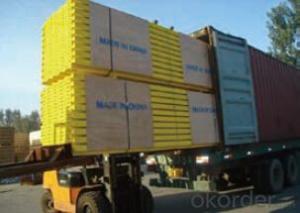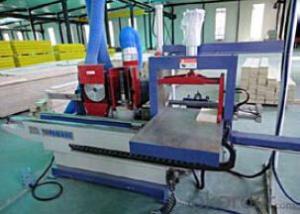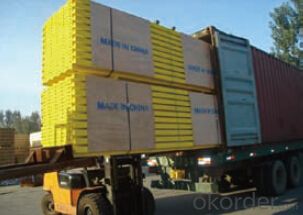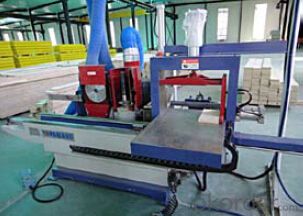Timber beam H20 for formwork and scaffolding system
- Loading Port:
- Tianjin
- Payment Terms:
- TT OR LC
- Min Order Qty:
- 50 m²
- Supply Capability:
- 1000 m²/month
OKorder Service Pledge
OKorder Financial Service
You Might Also Like
Characteristics:
◆ Standardized production lines.
Supply capability: 3000m/day, Lmax = 6600mm.
◆ Finger jointing of the flange and web, the strength of timber beam is highly improved.
Max. shearing force failure load:40KN
◆ Well treated to prevent from water penetration or erosion, so the service life maximally extended.
Normally, CNBM timber beam H20 can be used for 4 to 5 years, the exact using time would depend on maintenance & storage.
◆ Robust caps at the end of the girders protect against damages.
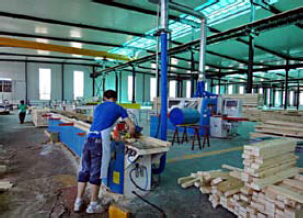
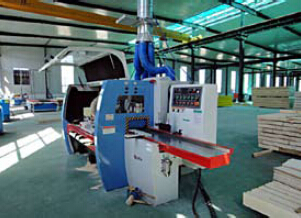
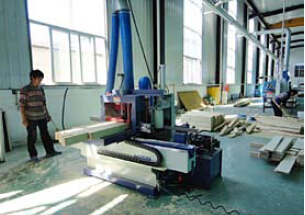
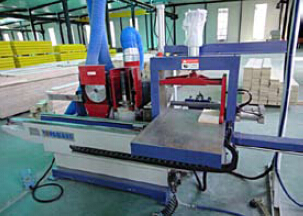
- Q: Can steel formwork be used for architectural concrete finishes?
- Yes, steel formwork can be used for architectural concrete finishes. Steel formwork offers a number of advantages that make it suitable for creating high-quality architectural finishes. Firstly, steel formwork provides excellent dimensional accuracy and stability, ensuring that the concrete is poured and cured in the desired shape and size. This allows for precise and intricate architectural detailing. Furthermore, steel formwork is highly durable and can withstand the pressure and weight of the concrete during the pouring and curing process. This durability ensures that the formwork remains intact and does not deform or warp, resulting in a smooth and even concrete finish. Steel formwork also allows for easy demolding, as it can be easily dismantled without damaging the concrete structure. This makes it convenient for achieving architectural finishes that require complex shapes or multiple components. In addition, steel formwork can be easily reused, making it a cost-effective option for architectural projects. It can withstand multiple uses, reducing the need for frequent replacements and saving both time and money. However, it is important to note that the choice of formwork material depends on the specific requirements of the architectural concrete finish. While steel formwork is suitable for most applications, there may be instances where other materials such as wood or plastic formwork are more appropriate. Consulting with a structural engineer or a construction professional can help determine the most suitable formwork material for a particular architectural concrete finish.
- Q: What are the different types of ties used in steel formwork construction?
- Steel formwork construction utilizes various types of ties to hold the formwork panels together and ensure the stability and integrity of the structure. Some commonly used ties in this construction method include: 1. Snap ties are the most frequently employed ties in steel formwork construction. They consist of a metal rod and a flat plate. The rod is inserted through holes in the formwork panels, and the plate is attached to secure the panels. Snap ties are quick and easy to install and can be easily removed after the concrete cures. 2. Tie rods are long steel rods with threading on both ends. They are used to connect the formwork panels by passing them through the panel holes and securing them with nuts and washers. Tie rods provide robust and stable connections that can withstand high pressure and loads. 3. She-bolts are similar to tie rods but have a fixed female thread at one end. Used in combination with wing nuts and washers, she-bolts hold the formwork panels together. They are particularly useful when tie rods need to be quickly and easily removed. 4. Flat ties are flat-shaped steel wires or bars. They are inserted through the formwork panel holes and secured with cones or washers. Flat ties establish a secure connection between the panels and are commonly used in large-scale construction projects. 5. Coil ties are flexible steel wires coiled at one end and threaded at the other. They are inserted through the formwork panel holes and secured with cones or washers. Coil ties are especially advantageous in curved or irregular-shaped structures. 6. Combination ties merge the characteristics of snap ties and tie rods. They consist of a metal rod with a flat plate at one end and a threaded end at the other. Combination ties are versatile and can be utilized in diverse formwork applications. Choosing the appropriate tie type is crucial for steel formwork construction projects. Factors such as the structure's size and shape, required load-bearing capacity, and ease of installation and removal influence the tie selection.
- Q: How does steel formwork accommodate for different concrete compaction methods?
- Steel formwork is an adaptable construction material capable of accommodating various concrete compaction methods with ease. Its strength and rigidity are key advantages, allowing it to withstand the forces exerted during compaction techniques. When utilizing compaction methods such as hand tamping or a vibrating poker, steel formwork provides a stable and secure surface for applying the necessary forces. The rigid and tightly connected steel panels ensure that the concrete remains in place and maintains its shape throughout the compaction process. This facilitates efficient and effective compaction, resulting in a uniform and high-quality concrete finish. In instances where mechanical compaction methods such as plate compactors or vibrating rollers are employed, steel formwork readily adapts to the added weight and vibrations. The robustness of the steel panels enables them to support heavy equipment and absorb vibrations without deformation or cracking. This guarantees even compaction of the concrete, eliminating any potential weak spots or voids. Moreover, steel formwork can be easily adjusted and modified to accommodate diverse compaction methods. The panels can be effortlessly repositioned or removed to allow proper access and movement for compaction equipment. Additionally, steel formwork can be tailored to specific shapes and sizes to meet the requirements of the compaction method employed. In summary, steel formwork offers a dependable and flexible solution for accommodating various concrete compaction methods. Its strength, rigidity, and adaptability make it an ideal choice for construction projects that necessitate efficient and effective compaction techniques.
- Q: Can steel formwork be used for underground parking structures?
- Yes, steel formwork can be used for underground parking structures. Steel formwork offers several advantages such as strength, durability, and the ability to withstand the pressure exerted by the surrounding soil. It provides a stable framework for pouring concrete and allows for quick and efficient construction of underground parking structures.
- Q: What are the challenges of using steel formwork?
- One of the main challenges of using steel formwork is its high initial cost compared to other types of formwork. Steel formwork also requires skilled labor for its installation and removal, which can increase project expenses. Additionally, steel formwork is heavy and requires special transportation and handling equipment, making it less convenient and cost-effective for small-scale projects. Finally, steel formwork requires proper maintenance to prevent corrosion and ensure its longevity, adding to the overall cost and effort involved in its use.
- Q: How does steel formwork handle different concrete finishes?
- Steel formwork is a popular choice in construction due to its durability and versatility. When it comes to handling different concrete finishes, steel formwork has proven to be highly effective. One of the key advantages of steel formwork is its smooth and rigid surface. This allows for a wide range of concrete finishes to be achieved with ease. Whether it is a smooth finish, textured finish, or even an exposed aggregate finish, steel formwork can handle them all. For smooth finishes, the steel formwork provides a level and even surface, allowing the concrete to be poured and finished seamlessly. The smooth surface of the steel formwork also helps in achieving a high-quality finish with minimal imperfections such as air pockets or surface blemishes. In cases where textured finishes are desired, steel formwork can easily accommodate various textures. This can be achieved by using specialized liners or inserts that are fixed to the steel formwork. These liners or inserts create the desired texture on the surface of the concrete as it sets, resulting in a textured finish. Additionally, steel formwork can handle exposed aggregate finishes exceptionally well. Exposed aggregate finishes involve exposing the aggregates (such as stones or gravel) in the concrete mix to create a decorative and textured surface. Steel formwork with its smooth surface allows the aggregates to be evenly distributed and exposed when the concrete is finished and cured. Moreover, steel formwork is known for its reusability. This means that it can be used multiple times without compromising its structural integrity or surface quality. This reusability factor makes steel formwork a cost-effective choice for handling different concrete finishes as it can be reused for various projects. In conclusion, steel formwork is highly versatile and can handle different concrete finishes effectively. Its smooth and rigid surface allows for a range of finishes to be achieved, including smooth, textured, and exposed aggregate finishes. Additionally, the reusability factor of steel formwork makes it an economical choice for contractors and construction projects.
- Q: What are the considerations when designing steel formwork for architectural sculptures?
- When designing steel formwork for architectural sculptures, there are several important considerations that need to be taken into account. Firstly, the structural integrity and stability of the formwork is paramount. The formwork must be able to withstand the weight of the concrete or other materials that will be poured into it, as well as any external forces that may be applied during the construction process. This requires careful analysis and engineering to ensure that the formwork is strong enough to support the weight and forces without any risk of collapse. Secondly, the accuracy and precision of the formwork is crucial. Architectural sculptures often require intricate and detailed designs, so the formwork must be able to accurately reproduce these shapes. This may involve using advanced computer-aided design (CAD) software to create precise 3D models of the sculpture, which can then be used to fabricate the formwork. Another consideration is the ease of assembly and disassembly of the formwork. Architectural sculptures can be complex and intricate, so the formwork must be designed in a way that allows for easy assembly and disassembly. This may involve using modular components that can be easily connected and disconnected, as well as incorporating features such as adjustable supports or brackets to accommodate different shapes and sizes. Additionally, the choice of materials for the formwork is important. Steel is a common choice due to its strength and durability, but other materials such as aluminum or fiberglass may also be used depending on the specific requirements of the project. The materials used must be able to withstand the weight and forces applied during construction, as well as any potential exposure to weather or other environmental conditions. Finally, considerations should be made for the aesthetics of the formwork. While the primary function of the formwork is to support the construction process, it is also important that it does not detract from the overall visual impact of the sculpture. This may involve using smooth finishes, hidden connections, or other design techniques to ensure that the formwork remains visually appealing. In conclusion, designing steel formwork for architectural sculptures requires careful consideration of factors such as structural integrity, accuracy, ease of assembly, material selection, and aesthetics. By addressing these considerations, designers can ensure that the formwork is not only functional and safe but also enhances the overall artistic vision of the sculpture.
- Q: Are there any specific design considerations for steel formwork?
- Yes, there are specific design considerations for steel formwork. These include factors such as the strength and stability of the steel structure, the weight-bearing capacity of the formwork, ease of assembly and disassembly, compatibility with different concrete mixtures, and the ability to withstand various site conditions such as weather and construction loads. Additionally, the design should also consider the reusability and durability of the steel formwork system to ensure cost-effectiveness and sustainability in construction projects.
- Q: Can steel formwork be used for precast concrete slabs?
- Yes, steel formwork can be used for precast concrete slabs. Steel formwork is a commonly used method for creating the molds or formwork for pouring concrete in precast construction. Steel formwork offers several advantages, including high durability, reusability, and superior strength compared to other types of formwork materials. It provides a rigid and stable structure that can withstand the weight and pressure of the concrete during the casting process. Steel formwork also allows for precise shaping and finishing of the concrete slabs, ensuring a high-quality and consistent end product. It can be easily assembled and disassembled, making it suitable for repetitive use in precast concrete production. Additionally, steel formwork can be designed and customized to meet specific project requirements, including different sizes, shapes, and patterns for the concrete slabs. However, it is important to consider the cost and maintenance of steel formwork, as it can be more expensive compared to other types of formwork materials such as wood or plastic. Regular maintenance and cleaning are necessary to ensure the longevity and efficiency of steel formwork. Overall, steel formwork is a reliable and widely used option for creating molds for precast concrete slabs, offering numerous benefits in terms of strength, durability, and customization options.
- Q: How does steel formwork affect the overall energy efficiency of a building?
- Steel formwork can significantly affect the overall energy efficiency of a building in several ways. Firstly, steel formwork provides a robust and durable structure that can withstand high pressures, ensuring a tight and well-insulated building envelope. This prevents air leakage, reducing heat loss or gain through walls and floors, thereby improving energy efficiency. Secondly, steel formwork allows for precise construction, resulting in tighter joints and fewer gaps, which minimizes thermal bridging. Thermal bridging occurs when heat transfers through materials with high thermal conductivity, leading to energy loss. By reducing thermal bridging, steel formwork enhances insulation and reduces energy consumption. Additionally, steel formwork enables the integration of insulation materials within the construction process. Insulation can be added between the steel panels, further enhancing the energy efficiency of the building by minimizing heat transfer through the walls and floors. Furthermore, steel formwork systems often allow for the reuse of materials, reducing waste and minimizing the environmental impact of construction. This sustainable approach aligns with energy-efficient practices, as it reduces the need for new resources and lowers the embodied energy of the building. Overall, steel formwork positively impacts the energy efficiency of a building by providing a sturdy structure, minimizing thermal bridging, facilitating insulation integration, and promoting sustainable construction practices.
Send your message to us
Timber beam H20 for formwork and scaffolding system
- Loading Port:
- Tianjin
- Payment Terms:
- TT OR LC
- Min Order Qty:
- 50 m²
- Supply Capability:
- 1000 m²/month
OKorder Service Pledge
OKorder Financial Service
Similar products
Hot products
Hot Searches
Related keywords
